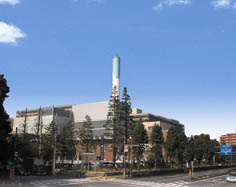State-of-the-Art Waste Treatment and Recycling Plant Delivered to Clean Association of Tokyo 23
May. 27, 2008

Tokyo, May 27, 2008 — Kawasaki Plant Systems, Ltd. announced today that it has delivered a state-of-the-art waste treatment plant to the Clean Association of Tokyo 23. The plant consists of Kawasaki’s proprietary fluidized bed-type gasification-melting system and plasma-type ash melting system. These plant components make optimum use of natural resources as well as recycled energy and have been designed to leave a minimum footprint on the environment while offering a maximum benefit to the community. It meets strict environmental standards in Japan for dioxins, exhaust gas, effluent emissions, fly ash leachate, and slag. Electricity generated by a steam turbine power generator that utilizes waste heat as well as photovoltaic panels is used to run plant facilities. The plant is the largest gasification-melting system currently operating in Japan for use in municipal waste treatment and the first to be used in a large city. This plant is the 160th waste treatment system Kawasaki has delivered. It is a model plant that essentially combines the latest feasible technologies that Kawasaki has developed over the years. Technological features of this plant include: (2) The Kawasaki plasma-type ash melting system |





